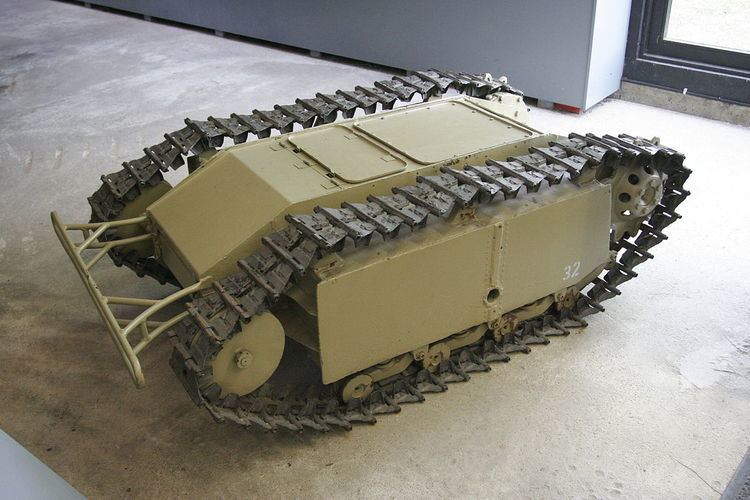In service 1942-1945 Designed 1942 | Place of origin Germany | |
 | ||
The Goliath tracked mine - complete German name: Leichter Ladungsträger Goliath (Sd.Kfz. 302/303a/303b) - was a remote controlled German-engineered demolition vehicle, also known as the beetle tank to the Allies.
Contents
Employed by the Wehrmacht during World War II. It carried 60 or 100 kilograms (130 or 220 lb) of high explosives, depending on the model, and was intended to be used for multiple purposes, such as destroying tanks, disrupting dense infantry formations, and demolition of buildings and bridges.
Development and use
In late 1940, after recovering the prototype of a miniature tracked vehicle developed by the French vehicle designer Adolphe Kégresse near the Seine, the Wehrmacht's ordnance office directed the Carl F.W. Borgward automotive company of Bremen, Germany to develop a similar vehicle for the purpose of carrying a minimum of 50 kg of explosives. The result was the SdKfz. 302 (Sonderkraftfahrzeug, ‘special-purpose vehicle’), called the Leichter Ladungsträger (‘light charge carrier’), or Goliath, which carried 60 kilograms (130 lb) of explosives. The vehicle was steered remotely via a joystick control box. The control box was attached to the Goliath by a triple-strand cable connected to the rear of the vehicle, for transmitting power to the electric driven version. Two of the strands were used to move and steer the Goliath, while the third was used for detonation. The Goliath had 650 metres (2,130 ft) of cable. Each Goliath was disposable, being intended to be blown up with its target. Early model Goliaths used an electric motor but, as these were costly to make (3000 Reichsmarks) and difficult to repair in a combat environment, later models (known as the SdKfz. 303) used a simpler, more reliable gasoline engine.
Goliaths were used on all fronts where the Wehrmacht fought, beginning in early 1942. They were used principally by specialized Panzer and combat engineer units. Goliaths were used at Anzio in Italy in April 1944, and against the Polish resistance during the Warsaw Uprising 1944. A few Goliaths were also seen on the beaches of Normandy during D-Day, though most were rendered inoperative due to artillery blasts severing their command cables. A small number of Goliaths were also encountered by allied troops in the Maritime Alps following the landings in southern France in August 1944, with at least one being used successfully against a vehicle of the 509th Parachute Infantry Battalion.
Although a total of 7,564 Goliaths were produced, the single-use weapon was not considered a success due to the high unit cost, low speed (just above 6 miles per hour (9.7 km/h)), poor ground clearance (just 11.4 centimeters), vulnerable command cables and thin armour which failed to protect the remote bomb from any form of antitank weapons. The Goliath did help lay the foundation for post-war advances in remote-controlled vehicle technologies.
Romanian version
During 1944, Romania designed and built its own model of remote-controlled tracked mine, known as "Romanian Goliath", due to lack of information about its actual name. However, it was markedly different from its German counterpart. The few surviving photos show that the vehicle had no armor, and it is not known if that was ever changed. It did have some logistical improvements, however, as the Romanian-designed chassis allowed it to cross trenches and craters much better than its German counterparts. Little is known about the stats of this Romanian vehicle, aside from the fact that it never went beyond the prototype stage and that it weighed about two tons.
Surviving examples
Surviving Goliaths are preserved at:
